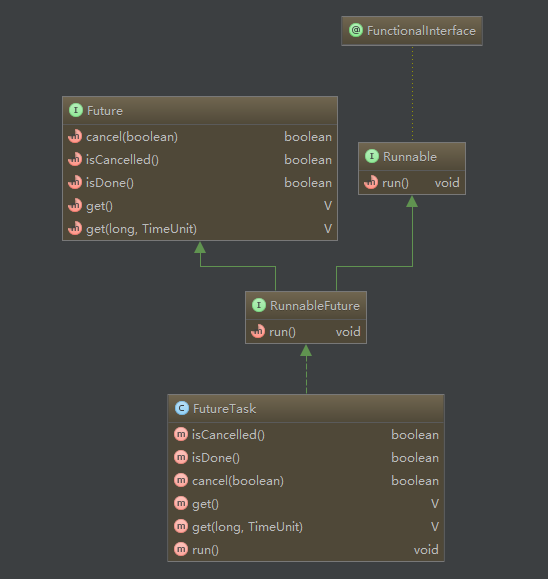本文主要介绍了自己对于juc包中的Future及FutureTask类中相关API的学习及实现原理的理解。
前言
Future接口给我们提供了一些监测开启的任务的运行状态的方法,比如get()方法阻塞直到查询的任务执行完毕,cancel()方法取消一个任务的执行等等。FutureTask类是Future接口的一个实现,它同时还实现了Runnable接口,可以作为Thread中执行的任务。使用示例如下:
public class FutureStudy {
public static void main(String[] args) {
Task task = new Task();
FutureTask<Integer> futureTask = new FutureTask<>(task);
Thread thread = new Thread(futureTask);
thread.start();
try {
Thread.sleep(1000);
} catch (InterruptedException e1) {
e1.printStackTrace();
}
System.out.println("主线程在执行任务");
try {
System.out.println("task运行结果" + futureTask.get()); // 阻塞直到call方法内任务执行完毕
} catch (InterruptedException e) {
e.printStackTrace();
} catch (ExecutionException e) {
e.printStackTrace();
}
System.out.println("所有任务执行完毕");
}
static class Task implements Callable<Integer> {
@Override
public Integer call() throws Exception {
System.out.println("子线程在进行计算");
Thread.sleep(3000);
int sum = 0;
for(int i = 0; i < 100; i++)
sum += i;
return sum;
}
}
}
接下来就来看下FutureTask内部各方法的实现原理。
FutureTask类源码分析
首先来看下FutureTask的UML图:

构造方法与成员变量
成员变量如下:
/**
* 用来标识一个任务的运行状态,初始时设置为NEW,仅在方法set,setException和cancel中转换为最终状态
* 在完成期间,状态可以采用COMPLETING的瞬态值(当设置结果时)或INTERRUPTING(在中断runner以满足cancel(true)时)。
* 从这些中间状态到最终状态的转换使用更便宜的ordered/lazy writes,因为值是唯一的并且不能进一步修改。
*
* 有可能出现的状态转换包含:
* NEW -> COMPLETING -> NORMAL
* NEW -> COMPLETING -> EXCEPTIONAL
* NEW -> CANCELLED
* NEW -> INTERRUPTING -> INTERRUPTED
*/
private volatile int state;
private static final int NEW = 0;
private static final int COMPLETING = 1;
private static final int NORMAL = 2;
private static final int EXCEPTIONAL = 3;
private static final int CANCELLED = 4;
private static final int INTERRUPTING = 5; // 状态5与状态6何时会出现???
private static final int INTERRUPTED = 6;
private Callable<V> callable; // 实际运行的任务,构造函数中传入
private Object outcome; // 存储返回的结果或者从get方法中要抛出的exception
private volatile Thread runner; // 运行callable中call方法的线程; CASed during run()
private volatile WaitNode waiters; // 等待队列,保存所有等待获取结果的线程
构造方法如下:
public FutureTask(Callable<V> callable) {
if (callable == null)
throw new NullPointerException();
this.callable = callable;
this.state = NEW; // ensure visibility of callable
}
public FutureTask(Runnable runnable, V result) {
this.callable = Executors.callable(runnable, result);
this.state = NEW; // ensure visibility of callable
}
run方法源码解析
在上面代码示例中,以new Thread(futureTask).start()的方式开启了一个新的线程,新线程开始执行之后首先执行的必然是FutureTask类中的run方法:
public void run() {
// 上一个任务未执行完或者CAS将执行任务的线程设置为当前线程失败
// 一个FutureTask实例对象在run方法执行一次之后,此FutureTask就不可再被执行了,因为其状态不再为NEW
if (state != NEW ||
!UNSAFE.compareAndSwapObject(this, runnerOffset,
null, Thread.currentThread()))
return;
try {
Callable<V> c = callable; // 创建FutureTask实例对象时传入的callable对象
if (c != null && state == NEW) {
V result;
boolean ran;
try {
result = c.call();
ran = true;
} catch (Throwable ex) {
result = null;
ran = false;
setException(ex);
}
if (ran)
set(result);
}
} finally {
// runner must be non-null until state is settled to
// prevent concurrent calls to run()
runner = null;
// state must be re-read after nulling runner to prevent
// leaked interrupts
int s = state;
if (s >= INTERRUPTING)
handlePossibleCancellationInterrupt(s);
}
}
// run方法执行过程中不论是顺利获得结果还是抛出异常,都将其存储在outcome对象中
protected void set(V v) {
if (UNSAFE.compareAndSwapInt(this, stateOffset, NEW, COMPLETING)) {
outcome = v;
UNSAFE.putOrderedInt(this, stateOffset, NORMAL); // final state
finishCompletion();
}
}
protected void setException(Throwable t) {
if (UNSAFE.compareAndSwapInt(this, stateOffset, NEW, COMPLETING)) {
outcome = t;
UNSAFE.putOrderedInt(this, stateOffset, EXCEPTIONAL); // final state
finishCompletion();
}
}
// 作用是自旋等待状态由INTERRUPTING变为INTERRUPTED
private void handlePossibleCancellationInterrupt(int s) {
if (s == INTERRUPTING)
while (state == INTERRUPTING)
Thread.yield(); // wait out pending interrupt
}
get方法源码解析
FutureTask类中get()方法会一直阻塞到等待的线程执行完毕,get(long timeout, TimeUnit unit)可以指定阻塞时间,两方法内部实现原理大致相同,这里仅介绍get()方法内部实现:
public V get() throws InterruptedException, ExecutionException {
int s = state;
if (s <= COMPLETING) // 如果线程正在执行过程中,但是还没有执行完毕
s = awaitDone(false, 0L);
return report(s);
}
private V report(int s) throws ExecutionException {
Object x = outcome;
if (s == NORMAL) // 正常结束,返回执行结果
return (V)x;
if (s >= CANCELLED) // future.cancel中取消了此任务
throw new CancellationException();
throw new ExecutionException((Throwable)x); // run方法中抛出的异常保存在了outcome对象中,现在向上抛出
}
// 等待绑定的线程执行完毕或者由于中断或超时放弃等待
private int awaitDone(boolean timed, long nanos)
throws InterruptedException {
final long deadline = timed ? System.nanoTime() + nanos : 0L;
WaitNode q = null;
boolean queued = false;
for (;;) {
if (Thread.interrupted()) { // 等待的线程由于中断从park中被唤醒
removeWaiter(q);
throw new InterruptedException();
}
int s = state;
if (s > COMPLETING) {
if (q != null)
q.thread = null;
return s;
}
else if (s == COMPLETING) // cannot time out yet
Thread.yield();
else if (q == null)
q = new WaitNode();
else if (!queued)
queued = UNSAFE.compareAndSwapObject(this, waitersOffset,
q.next = waiters, q); // 将当前线程包装后加入等待队列
else if (timed) {
nanos = deadline - System.nanoTime();
if (nanos <= 0L) {
removeWaiter(q);
return state;
}
LockSupport.parkNanos(this, nanos);
}
else
LockSupport.park(this);
}
}
static final class WaitNode {
volatile Thread thread;
volatile WaitNode next;
WaitNode() { thread = Thread.currentThread(); }
}
cancel方法源码解析
cancel方法尝试终止这个future绑定到的任务的执行,如果对应的任务已经完成、已经被cancelled、或者由于一些其它原因不能被cancelled,这次尝试就会失败。当cancel方法被调用的时候,如果这个任务还没有开始。这个任务就永远不会再执行;如果这个任务已经开始了,那么cancel方法中的mayInterruptIfRunning参数就决定了是否对正在执行任务的线程执行interrupt方法。
// mayInterruptIfRunning参数为true,即对正在执行任务的线程执行interrupt方法,否则则不执行
public boolean cancel(boolean mayInterruptIfRunning) {
if (!(state == NEW &&
UNSAFE.compareAndSwapInt(this, stateOffset, NEW,
mayInterruptIfRunning ? INTERRUPTING : CANCELLED))) // 先更改任务状态再进行cancel,保证cancel的可见性
return false;
try { // in case call to interrupt throws exception
if (mayInterruptIfRunning) {
try {
Thread t = runner;
if (t != null)
t.interrupt();
} finally { // final state
UNSAFE.putOrderedInt(this, stateOffset, INTERRUPTED);
}
}
} finally {
finishCompletion();
}
return true;
}
这个方法调用之后,接下来对于Future.isDone()方法的调用都会返回true,如果本次cancel方法返回true之后,接下来对于Future.isCancelled()的调用会一直返回true。
finishCompletion方法源码解析
在FutureTask到达最终状态之后(可能为NORMAL、EXCEPTIONAL、CANCELLED、INTERRUPTED),都会执行finishCompletion()方法,下面就来看看方法中究竟做了什么工作:
private void finishCompletion() {
// assert state > COMPLETING;
for (WaitNode q; (q = waiters) != null;) {
if (UNSAFE.compareAndSwapObject(this, waitersOffset, q, null)) { // 先将当前FutureTask中的waiters设为null
for (;;) { // 逐个唤醒等待线程
Thread t = q.thread;
if (t != null) {
q.thread = null;
LockSupport.unpark(t);
}
WaitNode next = q.next;
if (next == null)
break;
q.next = null; // unlink to help gc
q = next;
}
break;
}
}
done();
callable = null; // to reduce footprint
}
可见主要功能就是唤醒等待线程。
(完)